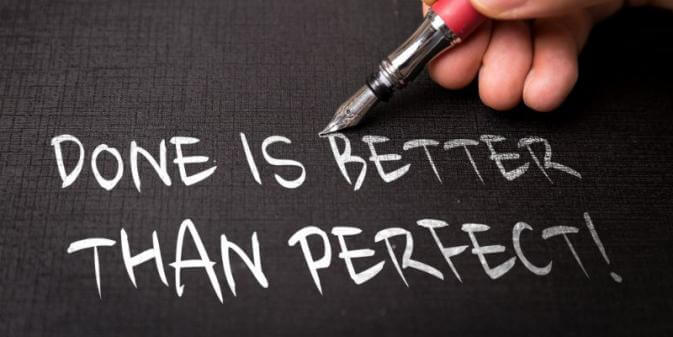How to Overcome Perfectionism
If you’re looking to perfect your perfectionism, keep your eye fixed on process, not output.
Today we’ll be talking about perfectionism.
Let’s take the following scenario: Bernice, proprietor of the Green Growing Things plant stores, decided she wanted to launch a course for her customers on the care and feeding of Audrey II plants. She put together an outline, subscribed to an online webinar service, and began to design the outline. For each topic, she recorded a video. Halfway through the course, she realized that the video made her look, well, bluish. She took a course on video production and realized her white balance was off, and decided to re-record the videos.
Then she realized that the checkout process for the webinar subscription was awkward. Surely, she should streamline that. And that means getting a payment processor that integrates with her webinar service.
By the time she got all that set up, technology had advanced and she realized that a 4:3 video aspect ratio was so…so…retro, and she should reshoot the video in 16:9 aspect ratio instead.
Five years later, she’s still working on getting the project perfect. No one but her has seen a moment of the video.
You’ll Never Reach the Perfect Output
Bernice is shooting for perfection of her finished product. Unfortunately, perfection of the output is a moving target. As you learn more and more about what you’re creating, you can simply raise your standards. Back before vacuum cleaners, the perfectly clean floors basically meant floors you could eat off of…and only get one or two mouthfuls of dirt.
Once vacuum cleaners came on the scene, however, standards changed. A perfect floor become one that you could eat off of with only one mouthful of dirt. And then eventually, no dirt. And now, perfection even includes anti-bacterial scrubs, whiteners, color brighteners, and all kinds of things. Outcome perfection is a moving target.
Perfection is In the Process
What you can perfect is the process. First off, expand your definition of “perfection” to include a time period. Instead of the best outcome you could possibly produce, shoot for the best outcome you can produce by a specific date. Bernice’s definition of perfection does not need to be a course shot in technicolor. It does need to be the best course she can create and still deliver by the time the store has its spring sale.
Furthermore, after the Spring Sale will be a Summer Sale. Then a Fall Sale. And then a Winter Sale. and then another Spring Sale. When we’re approaching a deadline, it always seems like that deadline is the date when, well, we’ll drop dead if we miss it. But actually that rarely happens. And if it does, we won’t care that we missed the deadline, because we’ll be dead. Or zombified. And if we don’t drop dead, then we’re still alive, and we can work on the next version of our product then.
Yes, I said “next version.” Bernice can produce a quick and dirty series of videos now, and then produce higher-quality versions over time once these are out in the field. In fact, if she notices that out of her 12 video series, only the videos on Audrey II tentacle care are getting many views, she might only have to produce that one video to professional standards.
The Perfect Process Learns
And that’s because the perfect process learns from experience. You can’t produce a perfect output the first time out any more than you can stop the seven horsemen of the apocalypse with a fake “One Way, Do Not Enter” street sign at the end of your block. What you can do is the best you can by the date you set. Then do an “after-action review.” Reflect on what worked and what didn’t, and decide how things could have gone better.
Then plan changes that will take your product to the next level. And by “product,” I mean whatever it is you’re working on. It may be your company’s product, or it may be trimming your beautiful suburban lawn to look like Kim Kardashian seen from above, or it may be finishing the pair of exciting underwear you’re knitting.
If you’re a perfectionist, let go of the need to have the perfect output. Instead, have the perfect process.
Bernice decides to go ahead and publish the videos she’s produced so far, even though they’re in the dreaded 4:3 aspect ratio. Much to her surprise, everyone loves them. In fact, the main feedback is that people would love to have her go in depth on the issue of choosing the right dental floss for an Audrey II that doesn’t brush regularly. So when she plans her summer video schedule, she can tackle this new topic.
Make Each Iteration a Chance to Learn
With each new production initiative, however, Bernice can up her game a bit. With her first video series, she learned to use her webcam. As she prepares her floss episode, she reads up on how to use lighting in video. After all, it’s dark inside an Audrey II’s mouth, and light will be needed.
She decides her goal for her next videos is to learn the basics of good lighting. Soon enough, Bernice is the Queen of White Balancing, and her videos are starting to look great. With every one, she learns what viewers do and don’t care about. She can get better and better over time; perfection doesn’t have to come all at once.
If you’re a perfectionist, let go of the need to have the perfect output. Instead, have the perfect process. Set a date and do the best you can by that date. Then review what you’ve learned, and set one goal for making your next round of improvements better than the first. Put your nose to the grindstone and do another round. In the time it takes to do five years’ worth of trying to create the perfect product immediately, you can do a dozen learning cycles, and be far closer to the perfect product than you ever thought possible.
I’m Stever Robbins. Follow GetItDoneGuy on Twitter and Facebook. Want great keynote speeches on productivity, Living an Extraordinary Life, or entrepreneurship? Hire me! Find me at SteverRobbins.
Image of perfectionism quote © Shutterstock







